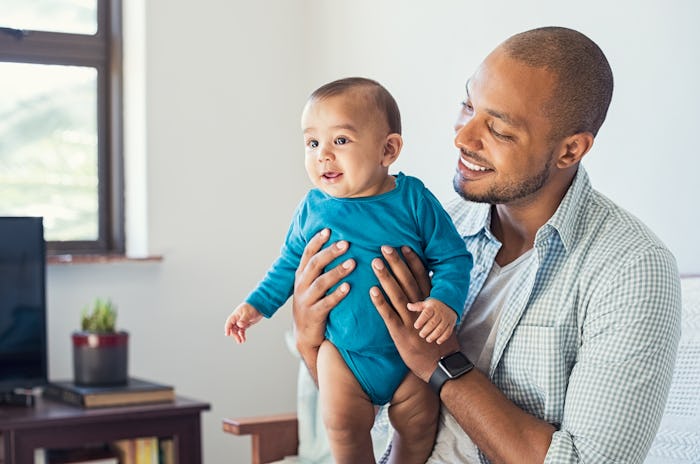Life

Here's How To Tell If Your Baby Is *Truly* Happy
Most parents will spend long hours gazing at their children, wondering what's going in in their adorable little baby heads. Do they dream of applesauce and their fluffy bunny plush? Do they feel warm and cozy when we're holding them? It's hard to think of babies as anything other than essentially happy creatures, given how quick they are to smile, coo, and laugh, but as it turns out, there are signs that your baby is happy that you might be missing.
Babies are pretty complex little creatures, in spite of how simple their lives are. Sure, most of their day revolves around bodily functions and staring at ceiling fans for fun, but they're constantly taking in everything around them, learning about their world through all of their senses. That's because at birth, babies aren't born with fully-developed brains, noted developmental psychologist Darcia F. Narvaez Ph.D. in the journal Psychology Today. What is developed is the survival instinct and the capacity to learn, and dependent upon a variety of factors, babies learn and thrive, growing up happy and healthy.
Basically? Babies are a pretty happy bunch, according to licensed clinical psychologist Dr. Dara Bushman, Psy.D. aka, "Dr. Dara". I contacted her and asked how you can tell specifically, and here is what she says.
1It's Usually Pretty Apparent: Use Your Instincts
Dr. Dara tells Romper that "there is nothing more authentic or genuine than the mood of a baby. They are transparent whether they are happy or sad." Think about it: when your baby is screaming bloody murder like you just slaughtered Peppa Pig for breakfast right in front of them, they're probably unhappy.
2Watch Their Gestures
"You can tell a baby is happy by verbal (baby verbal) and non-verbal gestures and cues. Babies' expression of contentment or discontentment vary based on age and development," says Dr. Dara. Very young babies are content and relaxed. They might not have a social smile yet, but they're not fussy or red, and they look almost serene. Fussy or angry babies look like the red dude from Inside Out.
3Learn How They Interact With The World
Each baby is unique, and eventually you'll get in tune with their rhythm. Dr. Dara tells Romper that "no two babies are the same, and every baby beats to the tune of their own drum. There is no mistaking the contentment of a baby when they smile and the wide eyed gleam in their eye. When a baby is happy ,they may coo, gargle, or verbally communicate with a soft noise." Each manifestation of happiness or contentment will be slightly different depending upon the baby. My kids used to make the "ahhh" sound over and over when they were happy babies, and you could always tell how happy they were by the pitch of the sound.
4You Can Physically Feel It
Emotion lives under our skin. As adults, when we're unhappy, we grind our teeth, clench our fists, sometimes our breath is short, and our skin gets hot. It's the same for babies, but more pronounced. They go stiff as little boards to the point where you can feel their muscles lock down.
Dr. Dara says that just like anger, you can feel contentment and happiness in your child. She notes, "When a baby is happy, you can hold them and sense the contentment and calmness in their body. You can hold them close and feel their stillness and warmth. You can feel the beat of their heartbeat as it feels like time stands still in the rest of the world."
5How Are You Feeling?
Dr. Dara says that "babies pick up on our energies and feel the emotion of their environment. Babies are more often happy when we are happy." That means that if you're relaxed and happy, they're more likely to be the same.
This article was originally published on